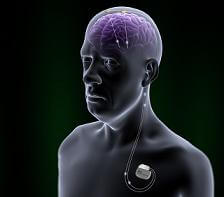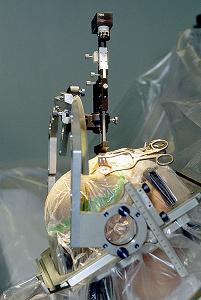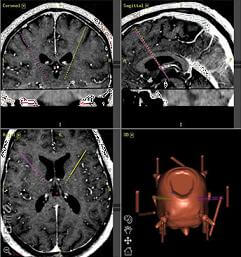
Those fighting conditions like dystonia, Parkinson’s Disease, and chronic pain have a way of alleviating their symptoms – direct electric shocks to their brain. Since 1997, deep brain stimulation (DBS) implants have slowly been gaining US FDA approval for use in patients (2002 for Parkinson’s, 2003 for dystonia). These ‘brain-pacers’ are surgically implanted in the chest but have long lead wires that reach up through the neck and deep into the brain. Electric stimulation from the implant can dramatically lessen the tremors associated with movement disorders, and experiments suggest they may help with OCD, depression, and severe cases of Tourette’s. According to Medtronic, the largest manufacturer of these deep brain stimulation devices, over 80,000 people around the world have a DBS implant. Eighty thousand! Did the age of mental cybernetics arrive while I wasn’t looking?
We’ve seen a few newsworthy brain implants in the last few years, including one designed to treat epilepsy and others that allow motor neurons to control computer cursors. But all of these devices were in the experimental phase of development. Medtronic’s DBS implants have been FDA approved for more than a decade (for some conditions) and such devices have been used tens of thousands of times. That’s beyond ‘experimental’, we’re reaching ‘well-tested’. If the number of patients treated with these devices continues to climb as it has in the past few years (we were at only 35,000 or so back in 2007) brain implants are going to become much more common in the next few years.

Keep in mind that these first generation devices are still rather crude. The best Medtronic has to offer has just eight electrodes (4 per lead), and scientists can only roughly target the desired areas needed to alleviate symptoms for disorders like Parkinson’s. In many ways DBS implants are basically just pace-makers with wires leading into your head.
Still, they’ve shown to reduce movement dysfunction in patients with Parkinson’s and dystonia, and to alleviate some cases of chronic pain. They’re also relatively safe, especially considering that you’re placing electrodes in the brain – the mortality rate is less than 1%
And these devices are getting better. We’ve seen how the next generation of DBS implants for Parkinson’s will be able to actively monitor and respond to brain activity. In the future, optogenetics will allow doctors to use light, not electricity, to stimulate parts of the brain (as we’ve seen with rodents). How widespread might these types of devices become when they have the precision to target just a few neurons at a time, and can respond autonomously to treat patients on their own?
Other companies are getting into the DBS implant market, St Jude’s Medical is gaining approval for its Libra device in Europe, and scientists are expanding the list of illnesses that may benefit from stimulation. Eighty thousand? Millions of people around the world have Parkinson’s Disease. Add in severe depression, or chronic pain and the potential number of patients for DBS implants gets very large very quickly. How long until the number of brain cyborgs passes 250,000? 1 million?

Typically I get excited about the idea of brain implants transitioning from treatment/repair to augmentation/enhancement. But even if we never pursue implants that increase mental performance, the sheer size of the restorative implant market is likely to be much bigger than anticipated. We should remember, too, that many movement disorders like Parkinson’s disproportionately affect the elderly. Could the prevalence of these devices reach 1% among aged patients in industrialized nations? I think it’s possible, especially as they become more advanced and versatile in the treatments they provide.
Deep brain stimulation implants are just one kind of medical implant that could find its way into our skulls. It’s already been used by more than 80,000 patients and there’s every reason to presume it will become more widespread in the near future. Other devices, as they transition out of the experimental phase of development, may find less resistance to adoption thanks to the early successes of DBS. Cybernetic implants are already here, and they’re only going to get more diverse and capable with time.
[image credits: St Jude’s Medical, Medtronic, WikiCommons]
[source: Medtronic, St. Jude’s Medical, NIH]



